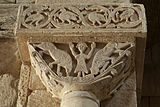San Pedro de la Nave
San Pedro de la Nave is a Visigothic church in El Campillo, a small town in the municipality of San Pedro de la Nave-Almendra , just under 20 km northwest of the city of Zamora , in the province of the same name in the Spanish autonomous region of Castile and León .
history
San Pedro de la Nave is considered a late example of Visigoth architecture. The church was probably built shortly before the Moorish conquest of Spain, which began in 711. The start of construction is dated to the reign of the Visigothic king Egica (r. 687–702), to the end of the 7th or beginning of the 8th century. The actual construction time should not have been more than a year. Originally the church belonged to a monastery in the valley of the Río Esla , near the Via de la Plata , the Roman road that connected the cities of Emerita Augusta ( Mérida ) and Asturica Augusta ( Astorga ). How long the monastery existed is not documented. The church was later used as a parish church. In 1912 it was declared a national treasure ( Bien de Interés Cultural ). In 1930 the church had to give way to the Ricobayo reservoir and was rebuilt only about two kilometers further southeast at its current location.
architecture
The building is made of reddish sandstone blocks of various sizes that are joined together without mortar ; some of the stones are precisely carved, others only a little. San Pedro de la Nave is a three-aisled basilica that forms a Greek cross ; the two half aisles on either side of the yoke in front of the apse are probably later additions, the purpose of which is unclear. The lantern tower ( cimborrio ) , which is open to the church and exposed to light through four window openings, rises above the crossing square . The original side aisles are separated from the main nave by arcades with horseshoe arches that are closed to varying degrees . The triumphal arch , which opens from the central nave to the square apse, is also designed as a horseshoe arch. Above it - as in other pre-Romanesque churches (e.g. San Baudelio de Berlanga , San Salvador de Priesca or Santiago de Peñalba ) - there is a so-called hidden chamber ( cámara oculta ), which is only accessible from the inside and via a ladder.

Double window
In the outer walls on both sides of the portal in the north transept, which has probably always been used as the main entrance, a window ( ajimez ) opens up . Such twin windows ( biforias or coupled windows ) probably go back to late antiquity models and should play an important role in the Moorish and Mudéjar architecture of later centuries, but also in the architecture of the Romanesque and Gothic , in a significantly refined and richer design .
Sculpture jewelry
Capitals
In front of the pillars of the crossing square are columns with figurative capitals . Two of these capitals depict birds picking grapes. There are human faces on the sides. Biblical scenes can be seen on the other two capitals . In one scene Abraham wields a knife against his son Isaac , lying on an altar in front of him , whom the hand of God is keeping from being killed. Behind Abraham stands a ram as a sacrificial animal. A Latin inscription is carved on the upper edge of the capital, the translation of which reads: "Where Abraham offered his son Isaac to the Lord as a sacrifice". Another scene shows the prophet Daniel in the lions 'den , above the inscription: "Where he was sent to the lions' den". The apostles Peter , Paul , Thomas and Philip are depicted on the sides of these two capitals . On the warriors above the capitals runs a frieze of vines that form circles and frame birds, human heads or grapes. Another frieze is attributed to another artist or sculptor's workshop. Geometric motifs are depicted on it, squares and circles set in dew bands with vines, flower petals and sun wheels .
Ornamental relief
At the level of the combat zone above the capitals there is a decorative ribbon in relief, which also includes the apse and the transept; The shapes used here are diverse and include both human and animal, vegetable and geometric motifs (heads, birds, vines, crosses, vortices, etc.). The fan rosette above the apse window and its framing in the form of an alfiz are remarkable .
See also
literature
- Luis Caballero Zoreda and Fernando Arce: La Iglesia de San Pero de la Nave (Zamora). Arqueología y Architectura . AEspA 70, 1997, pp. 221-274.
- Jaime Cobreros: Guía del Prerrománico en España . Madrid 2006, ISBN 84-9776-215-0 , pp. 137-141.
- Jacques Fontaine: L'Art Préroman Hispanique . Volume 1, 2nd edition, Éditions Zodiaque, Abbaye de la Pierre-Qui-Vire 1973, pp. 199-205.
- Pedro de Palol , Max Hirmer : Art of the early Middle Ages from the Visigoth Empire to the end of the Romanesque. Hirmer, Munich 1965, p. 16.
Web links
- San Pedro de la Nave - Photos + Info (arteguias, Spanish)
- San Pedro de la Nave - Photos + Info (Spanish)
Coordinates: 41 ° 34 ′ 59.8 " N , 5 ° 57 ′ 51.3" W.










